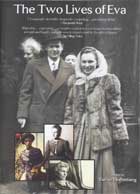
Les Deux Vies d’ Eva (The Two Lives of Eva) 2005
Distributed by First Run/Icarus Films, 32 Court St., 21st Floor, Brooklyn, NY 11201; 800-876-1710
Produced by Les Films du Poisson in coproduction with ARTE France & Lapsus
Directed by Esther Hoffenberg
DVD, color and b&, 85 min., French, German and Polish with English subtitles
Sr. High - Adult
World War II, Women's Studies, History
Date Entered: 06/18/2007
Reviewed by Maureen Puffer-Rothenberg, Valdosta State University, Valdosta, GALes Deux Vies d’Eva (The Two Lives of Eva) is Esther Hoffenberg’s exploration of her mother Eva’s childhood and young adulthood in World War II-era Poland. Through her mother’s own words and interviews with Eva’s cousins and the friends of her youth, Hoffenberg traces Eva’s life from her privileged childhood as the daughter of a German/Polish factory owner, through her post-war marriage to a Jewish survivor of the Warsaw ghetto. Eva suffered a series of mental breakdowns beginning in the 1970s; Hoffenberg links Eva’s emotional instability with guilt over her family’s acceptance of German citizenship under Hitler, and her having survived her two siblings during the war.
The extent of Eva’s involvement with the Nazis remains ambiguous, although Hoffenberg shows Eva’s onetime companions a photograph of a young Eva in military costume (only one woman can identify it as such) and quotes her as being uncomfortable giving the Nazi salute. These elderly women do not judge Eva in hindsight; they speak of their friend and cousin fondly and with humor, and recall her behavior as understandable if not honorable. Eva’s frequently anguished words sometimes contradict not only their accounts and attitudes, but also Esther Hoffenberg’s own memories of her mother’s family.
Interviews are interspersed with still photographs, home movies, juxtaposed views of painted and sculpted portraits of Eva’s family (placing family members in relation to each other, and recalling that Eva’s mother was an artist), generic archival footage and sequences of trees and roads rushing past the camera. An actress reads the words attributed to Eva, who appears only in home movies and still photographs.
The film subtly and beautifully reveals the ambiguities of memory—or perhaps the desire to rewrite the past—and how wartime experiences can reverberate through families and generations. Les Deux Vies d’Eva can be recommended to support secondary or college-level studies of European families, women or children in World War II, or as an example of the long-term psychological impact of war.
Awards
- Patrimony Prize, Cinéma du Réel Festival, 2005